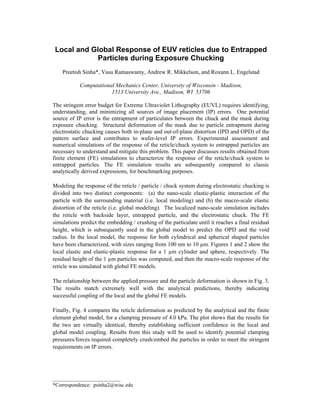
EIPBN 2010 Abstract_Preetish
- 1. Local and Global Response of EUV reticles due to Entrapped Particles during Exposure Chucking Preetish Sinha*, Vasu Ramaswamy, Andrew R. Mikkelson, and Roxann L. Engelstad Computational Mechanics Center, University of Wisconsin - Madison, 1513 University Ave., Madison, WI 53706 The stringent error budget for Extreme Ultraviolet Lithography (EUVL) requires identifying, understanding, and minimizing all sources of image placement (IP) errors. One potential source of IP error is the entrapment of particulates between the chuck and the mask during exposure chucking. Structural deformation of the mask due to particle entrapment during electrostatic chucking causes both in-plane and out-of-plane distortion (IPD and OPD) of the pattern surface and contributes to wafer-level IP errors. Experimental assessment and numerical simulations of the response of the reticle/chuck system to entrapped particles are necessary to understand and mitigate this problem. This paper discusses results obtained from finite element (FE) simulations to characterize the response of the reticle/chuck system to entrapped particles. The FE simulation results are subsequently compared to classic analytically derived expressions, for benchmarking purposes. Modeling the response of the reticle / particle / chuck system during electrostatic chucking is divided into two distinct components: (a) the nano-scale elastic-plastic interaction of the particle with the surrounding material (i.e. local modeling) and (b) the macro-scale elastic distortion of the reticle (i.e. global modeling). The localized nano-scale simulation includes the reticle with backside layer, entrapped particle, and the electrostatic chuck. The FE simulations predict the embedding / crushing of the particulate until it reaches a final residual height, which is subsequently used in the global model to predict the OPD and the void radius. In the local model, the response for both cylindrical and spherical shaped particles have been characterized, with sizes ranging from 100 nm to 10 µm. Figures 1 and 2 show the local elastic and elastic-plastic response for a 1 µm cylinder and sphere, respectively. The residual height of the 1 µm particles was computed, and then the macro-scale response of the reticle was simulated with global FE models. The relationship between the applied pressure and the particle deformation is shown in Fig. 3. The results match extremely well with the analytical predictions, thereby indicating successful coupling of the local and the global FE models. Finally, Fig. 4 compares the reticle deformation as predicted by the analytical and the finite element global model, for a clamping pressure of 4.0 kPa. The plot shows that the results for the two are virtually identical, thereby establishing sufficient confidence in the local and global model coupling. Results from this study will be used to identify potential clamping pressures/forces required completely crush/embed the particles in order to meet the stringent requirements on IP errors. __________________________ *Correspondence: psinha2@wisc.edu
- 2. (a) Elastic (b) Elastic-plastic Fig. 1. Local model results for a 1 µm cylindrical particle, illustrating (a) the elastic response and (b) the elastic-plastic response (a) Elastic (b) Elastic-plastic Fig. 2. Local model results for a 1 µm spherical particle, illustrating (a) the elastic response and (b) the elastic-plastic response 120000 100000 80000 Analytical FE p (Pa) 60000 40000 20000 0 0 0.2 0.4 0.6 0.8 1 δ (µm) Fig. 3. Comparison of the analytical and finite element results; Fig. 4. Comparison of the analytical and finite element reticle a plot of the relationship between the applied pressure deformation for a pressure of 4.0 kPa. and the particle deformation.